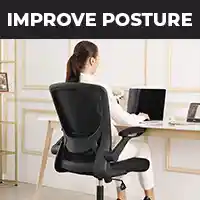How to Sit in a Chair with Scoliosis?
Scoliosis is an abnormality of the spinal curve in which the backbone twists or curves to the side. The sideway curvature of the spine not only changes the physical appearance of the shoulders, hip, and waist but also affects daily routine activities like sitting, standing, and doing work.
Sitting in a chair properly for scoliosis individuals without experiencing back pain is difficult. An accurate sitting posture is the most necessary thing to align the spinal curve naturally and prevent back discomfort.
Many people do not know how to sit in a chair with scoliosis properly for maximum back support and relief. That’s why we have made this helpful guide for scoliosis patients to sit comfortably and maintain their body posture in the right way while sitting in a chair.
What is Scoliosis?
Let’s first understand scoliosis disorder in detail before knowing how to sit with scoliosis. Scoliosis is a spinal disorder in which the spine (backbone) bends. Scoliosis can occur at any age of people, from children to adults.
If people with backbone disorder do not maintain the right body posture or don’t correct their sitting method, the scoliosis condition worsens and leads to back, shoulder, and leg pain. A good posture can reduce the pressure on the spine and distribute the body weight evenly.
According to the American survey, 3% of America’s population faces scoliosis and back pain due to the bending of the spinal curve. It is reported that scoliosis occurs in almost nine million individuals. The scoliosis condition can be improved and controlled with the right medications, accurate sitting method, proper therapy, physical therapy, and correct exercises.

The sideway curvature of the spine alters the body shape physically, which includes uneven shoulders, prominent change in hips structure, waist, and trunk moving to one side, and change in the appearance of the shoulder blade. This will lead to back pain, shoulder discomfort, hip pain, pain in the legs, and difficulty in moving, sitting, and standing. Therefore, it is necessary to learn the proper sitting method with scoliosis because it will help minimize the pain, ease movement, improve body posture, and sit without discomfort.
So, how to sit in a chair with scoliosis? The best method to sit in a chair with scoliosis is to keep your back straight while sitting in the chair. Avoid sitting on your seat’s edge and make sure to keep the pelvic region in a neutral position; don’t tilt your position forward or backward. Moreover, performing the thoracic extension during sitting is better for decreasing or relieving back pressure.
What are the Types of Scoliosis?
Scoliosis is classified into different types according to age and cause. Idiopathic scoliosis is the most commonly occurring type in people. Here we discuss the types of scoliosis briefly:
Idiopathic Scoliosis
The Idiopathic type of scoliosis occurs in 80% of the people than the other types. It occurs in both children and adults; however, from a survey, it is recorded that females suffer more from the Idiopathic type in comparison to males. The actual reason for this type is unknown, but it is related to genetics and abnormal development.
Congenital Scoliosis
It is a rare type of scoliosis that occurs at birth due to abnormal development of the spine in the uterus.
Neuromuscular Scoliosis
As the name indicates, this type occurs due to neurological or muscular disorders. It is common and becomes severe in people with cerebral palsy, spinal muscular atrophy, and muscular dystrophy.
Degenerative Scoliosis
This type is common in older aged individuals. Degenerative scoliosis is caused due to degenerative disc disease or osteoarthritis. In this type, the lumbar region of the spine is usually affected and leads the lower back pain.

What Are the Symptoms of Scoliosis?
The symptoms may vary according to type, age, gender, and genetics. However, below, we describe the common symptoms:
● One shoulder blade is higher than the other shoulder blade.
● Difficulty in breathing (due to decreased area in the lungs).
● Uneven shoulders or hips height
● Back and lower back pain
● Pain in the legs
● Fatigue
What are the Causes of Scoliosis?
The sideway curvature of the spine occurs due to genetics, poor body posture, and other medical reasons. According to SPINE-health, there are two significant categories of scoliosis: structural and nonstructural. Nonstructural scoliosis is a temporary abnormality that can be solved, but structural scoliosis is a permanent condition that occurs due to immature birth, injury, and other disease.
Other causes are as follows:
● Osteoporosis
● Genetics
● Congenital disabilities
● Bad posture
● Nerve abnormalities
How to Sit with Scoliosis?
We understand that it is challenging to maintain a good body posture for people with scoliosis, especially on office chairs. But you can improve your scoliosis condition by selecting the best chair for scoliosis and maintaining the ideal posture. The following are the best tips for sitting with scoliosis:
1. Maintain the Body Posture
The best way to sit with scoliosis is to understand and maintain the proper body posture. The below guidelines can improve the body posture:

● Always ensure that you sit back in the chair while keeping your back straight.
● You should try to avoid slouching and leaning towards the side of the chair.
● It is necessary that your body weight is equally distributed while sitting in a chair; therefore, do not tilt your pelvis forward or backward.
● Never cross your legs to attain better alignment of the spine during sitting in a chair. Crossing the legs is not only bad for the posture but also leads the lower back pain.
● Keep your shoulders and arms relaxed.
● Avoid high-impact activities like running and jumping.
● Sit in such a position in which your knees are lower than your hips.
● Keep in mind that your feet should not be hanged because it will put pressure on your lower back and cause lumbar pain.
● Avoid doing gymnastics with scoliosis, and don’t bend your neck forward.
2. Select a Comfortable and Best Chair
Choosing the best and most comfortable chair is the most important requirement to sit with scoliosis. The right ergonomic chair helps to improve body posture and reduce back pain. You should select a chair with lumbar support, adjustable features, adjustable seat height, comfortable armrests, and footrests to align the spine naturally. If you use soft sofas or armless desk chairs, the condition of scoliosis gets more severe
3. Use a Lumber Roll
Another useful tip to sit in a chair with scoliosis is to place a lumbar roll on the back of the chair. A lumbar roll is a small cylindrical shaped cushion that provides maximum support to the spinal cord. It also helps to reduce the strain on the muscles of the back. If your chair does not provide you with the maximum lumbar support, the lumbar roll is a great choice for you. Make sure that you place the lumbar roll in the correct position.
4. Perform Desk Exercises
If you are an office worker, who has to spend long hours sitting on a chair, we have the best tip for you to deal with scoliosis. You should perform desk chair exercises to strengthen the back muscles and reduce back stiffness. Thoracic extension exercises are simple exercises that you can do by the following instructions:
- At the start, lean over the back of the chair so that your head is facing forward.
- Next, stretch your back against the backrest of the chair by using your hands so that your shoulders form an X shape.
- Maintain and keep this position for 10 to 30 seconds.
Some other exercises which are useful to strengthen the muscles of people with scoliosis are as follows:
● Superman Exercises
● Cat Camel Stretches
● Bridge exercises
● Seated twist
● Wall angles
5. Take Breaks
Taking breaks during long hours of working and sitting is also a helpful way to sit with scoliosis. Frequent breaks and standing up help to improve blood circulation and minimizes the stiffness of muscles. So, we suggest you move or stretch during working to relax your muscles and relieve the body pain. If you forget to take breaks, set a reminder or timer.
6. Adjust the Chair Height and Footrest

It is also essential to adjust the height of the chair according to your body height. If your chair’s height is too high or too low than your body height, it will create strain in your muscles, especially for scoliosis people.
When adjusting the chair’s height, ensure that your knees are bending at a 90-degree position. Use the pillow or cushion to increase the height of the seat when the chair’s height is low. Choose an ergonomic chair with a comfortable and adjustable footrest for supporting the feet. An adjustable footrest gives you a stable surface.
Final Words
We tried our best to describe to you in detail about scoliosis and how to sit in a chair with scoliosis. Hopefully, using our tips, you can correct your posture, sit comfortably in a chair, and improve your scoliosis condition. Try to sit properly on the chair while keeping your back straight, and use a lumbar cushion for additional support. Never cross your legs, and don’t carry heavy items. We suggest you consult the physician and physical therapist for proper medication and exercises.







